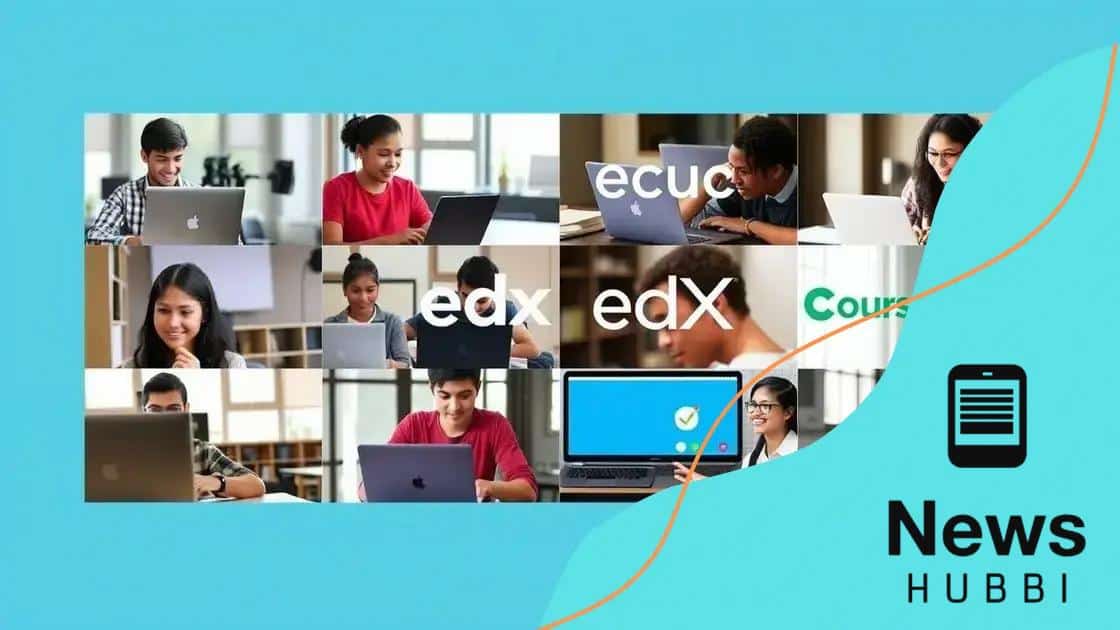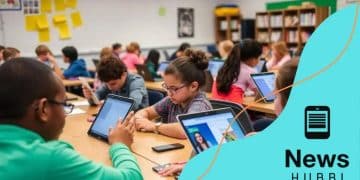The role of online learning in tackling global education inequality

Anúncios
The role of online learning in tackling global education inequality involves providing accessible education through technology, addressing barriers like the digital divide, and enhancing learning quality for diverse learners worldwide.
The role of online learning in tackling global education inequality is more significant than ever. With the rise of the internet, education has become more accessible, but is it enough? Let’s explore.
Anúncios
Understanding global education inequality
Understanding global education inequality is crucial as it sheds light on the barriers many children and adults face in accessing education. This inequality varies greatly across countries and regions, affecting millions of learners worldwide.
Education is not just about access; it’s about quality. In some areas, children attend schools with lacking resources, while in others, they have access to advanced technology and highly trained teachers. To comprehend this disparity, we need to explore various contributing factors.
Barriers to Access
Numerous obstacles prevent individuals from gaining education. They can be categorized into social, economic, and geographical barriers. Understanding these helps us address the challenges effectively.
Anúncios
- Poverty: Many families prioritize work over schooling due to financial struggles, limiting educational opportunities.
- Location: Rural areas often lack schools or transportation options, creating accessibility issues.
- Gender: In some cultures, girls face additional barriers to education compared to boys.
- Cultural Norms: Societal values can influence the importance placed on education, affecting attendance rates.
Beyond barriers, we also need to investigate the quality of education provided. A school may be accessible, but if it lacks trained educators or up-to-date curricula, students may not receive a meaningful education. This becomes a significant part of the conversation around global education inequality.
Quality of Education
Quality education means having access to well-trained teachers and relevant learning materials. In contrast, in less developed regions, the shortage of resources hampers learning. Here are some typical issues affecting educational quality:
- Unqualified Teachers: Many teachers may not have the proper training, impacting students’ learning experiences.
- Outdated Materials: Lack of access to modern learning tools can lead to disengagement among students.
- Large Class Sizes: High student-to-teacher ratios can hinder personalized attention and support for each learner.
These qualitative differences highlight why it is essential to advocate for systemic changes. By focusing on improving both access and quality, we can work toward reducing global education inequality together.
How online learning improves access to education

How online learning improves access to education is a vital topic as it addresses the ways technology has transformed the educational landscape. With the rise of the internet, learning has become more accessible than ever before, paving the way for countless individuals worldwide.
Online learning provides flexibility that traditional methods often cannot match. Learners can easily access a variety of resources from anywhere, allowing them to study at their own pace. This freedom can lead to better educational outcomes as students engage with material that interests them.
Breaking Geographical Barriers
One of the most significant advantages of online learning is its ability to break geographical barriers. Students from remote areas can now access quality education without the need for physical relocation.
- Remote Access: Individuals living in isolated regions can attend classes offered by prestigious institutions worldwide.
- Variety of Courses: Students can choose from numerous courses that may not be available in their local areas.
- Inclusive Learning: Online platforms can accommodate students with disabilities, ensuring everyone has the opportunity to learn.
This shift enables a diverse range of learners to access education that was previously out of reach. Additionally, online resources can facilitate language learning by providing content in multiple languages, thus catering to a global audience.
Cost-Effectiveness
Online education is often more cost-effective compared to traditional schooling. Many online courses are either free or available at a fraction of the cost of conventional classes. This affordability allows more people to develop skills and knowledge.
- Reduced Travel Costs: Students save money by eliminating daily commutes to campus.
- Free Resources: Many platforms offer free educational materials and tools.
- Flexible Payment Options: Online learning programs often provide payment plans to ease financial burdens.
The combination of affordability and accessibility makes online learning an attractive option for many. Despite the various benefits, there are still challenges to consider, such as ensuring internet access and digital literacy. However, the overall impact of online education in improving access to learning is profound and undeniable.
The impact of technology on learning quality
The impact of technology on learning quality is a critical consideration as we evaluate modern education. Today, technology plays a key role in shaping how educational content is delivered and consumed. This transformation has the potential to enhance learning experiences, making them more engaging and effective.
With the use of digital tools, students can interact with learning materials in ways that were not possible before. For example, videos, interactive simulations, and educational games provide students with opportunities to learn at their own pace. This targeted approach can help in addressing individual learning needs.
Enhanced Engagement
Technology captures students’ attention and keeps them engaged. Utilizing various platforms encourages a more active learning environment.
- Multimedia Resources: Integrating videos and animations can make complex concepts clearer.
- Interactive Learning: Online quizzes and games make learning fun and motivate students to participate.
- Immediate Feedback: Many tech tools offer instant feedback, allowing learners to understand their progress quickly.
This level of engagement can lead to better retention of information and improved understanding of subjects. Additionally, when students feel encouraged to participate, they are more likely to develop a passion for learning that lasts beyond the classroom.
Personalized Learning
Another significant effect of technology on learning quality is the ability to provide personalized education. Online platforms can adapt to the needs of each learner.
- Tailored Content: Educators can customize lessons based on individual student abilities and preferences.
- Flexible Learning Paths: Students can choose their own pathways to master skills, enhancing their ownership of the learning process.
- Access to a Wide Range of Materials: Learners can explore content from different sources to find what works best for them.
This customization helps students grasp difficult concepts more easily and improves their overall educational experience. With technology, teachers can monitor student progress and adjust their teaching methods accordingly.
As we continue to integrate technology into education, it is essential to keep evaluating its effectiveness. Balancing traditional and digital methods can ensure that learning quality remains high for all students, preparing them for future challenges.
Case studies of successful online education initiatives

Case studies of successful online education initiatives provide valuable insights into how technology can enhance learning experiences. These examples illustrate the potential impact of online education on various communities, showcasing effective strategies and innovative approaches.
One notable case is the Khan Academy, a non-profit organization that offers free online courses, lessons, and practice in a wide range of subjects. Their model has helped millions of students worldwide by providing personalized learning experiences. Students can learn at their own pace, accessing resources anytime and anywhere.
Project-Based Learning
Another successful initiative is the edX platform, which features university-level courses from institutions like Harvard and MIT. edX promotes project-based learning, allowing students to engage deeply with subjects and apply their knowledge practically.
- Collaborative Projects: Students work together on real-world problems, enhancing critical thinking and teamwork skills.
- Hands-On Activities: Courses often include practical assignments that encourage exploration and creativity.
- Diverse Learning Resources: Learners can access videos, readings, and forums to enrich their understanding.
This approach not only makes learning more engaging but also prepares students for future challenges in their careers.
International Reach
The Coursera platform offers an excellent example of how online education can reach global audiences. By partnering with top universities, Coursera provides courses that are accessible to anyone with an internet connection.
- Affordable Education: Many courses are offered for free or at a low cost, making higher education more accessible.
- Flexibility: Students can balance their studies with work or other commitments, promoting lifelong learning.
- Multilingual Courses: Courses are available in various languages, allowing non-native speakers to benefit from high-quality education.
These case studies demonstrate the effectiveness of online education initiatives in tackling global education inequality. By providing accessible, flexible, and engaging learning opportunities, these platforms empower students worldwide.
Challenges and solutions in online learning
Challenges and solutions in online learning are critical topics in today’s educational landscape. As more learners adapt to digital platforms, it is essential to identify the obstacles they face and explore effective solutions.
One major challenge is the issue of digital divide. Not all students have access to reliable internet or technology. This inequality can hinder participation in online courses, especially in rural or low-income areas. The lack of resources means that some learners are left behind, unable to benefit from the same opportunities as their peers.
Addressing the Digital Divide
To tackle the digital divide, several solutions can be implemented. Schools and organizations can work together to provide resources and support.
- Government Programs: Initiatives that offer free or subsidized internet access to low-income families can bridge the gap.
- Community Centers: Providing internet access at local community centers allows students to have a reliable place to learn.
- Device Donations: Programs that donate laptops or tablets to students can significantly improve access to online learning materials.
By addressing these issues, we open up opportunities for all students, ensuring that online learning can be truly inclusive.
Engagement and Motivation
Another common challenge is maintaining student engagement in an online environment. With distractions at home and limited face-to-face interaction, some learners may find it difficult to stay motivated. This can result in lower participation rates and performance.
- Interactive Tools: Using interactive platforms and gamification techniques can make learning more engaging and fun for students.
- Regular Check-Ins: Teachers can conduct frequent check-ins to offer support and keep students accountable.
- Peer Collaboration: Encouraging collaboration through group projects or discussion forums can foster a sense of community.
These strategies can foster a more supportive and engaging online learning environment. To ensure success, educators should continuously adapt their methods to meet the needs of their students. By implementing effective solutions, we can overcome the challenges posed by online learning.
The transformation brought by online learning is vital in bridging the gap of education inequality around the world. As we have seen, technology offers tremendous resources that enhance learning access and quality. While challenges such as the digital divide and engagement remain, effective solutions can pave the way for a more inclusive future. By continuing to adapt and innovate, we can ensure that every learner has the opportunity to succeed, no matter their background. The future of education looks promising, and it is our responsibility to support these advancements.
FAQ – Frequently Asked Questions about Online Learning and Education Inequality
What is the digital divide in online education?
The digital divide refers to the gap between individuals who have access to technology and the internet and those who do not. This discrepancy can hinder educational opportunities for many students.
How can technology enhance student engagement?
Using interactive tools, gamification, and collaborative projects can significantly increase student engagement and motivation in online learning environments.
What are some effective solutions to improve online learning?
Solutions include providing free or subsidized internet access, integrating personalized learning paths, and encouraging community support through local centers.
How does online learning prepare students for the future?
Online learning equips students with important skills such as digital literacy, self-motivation, and adaptability, which are essential for success in today’s workforce.





